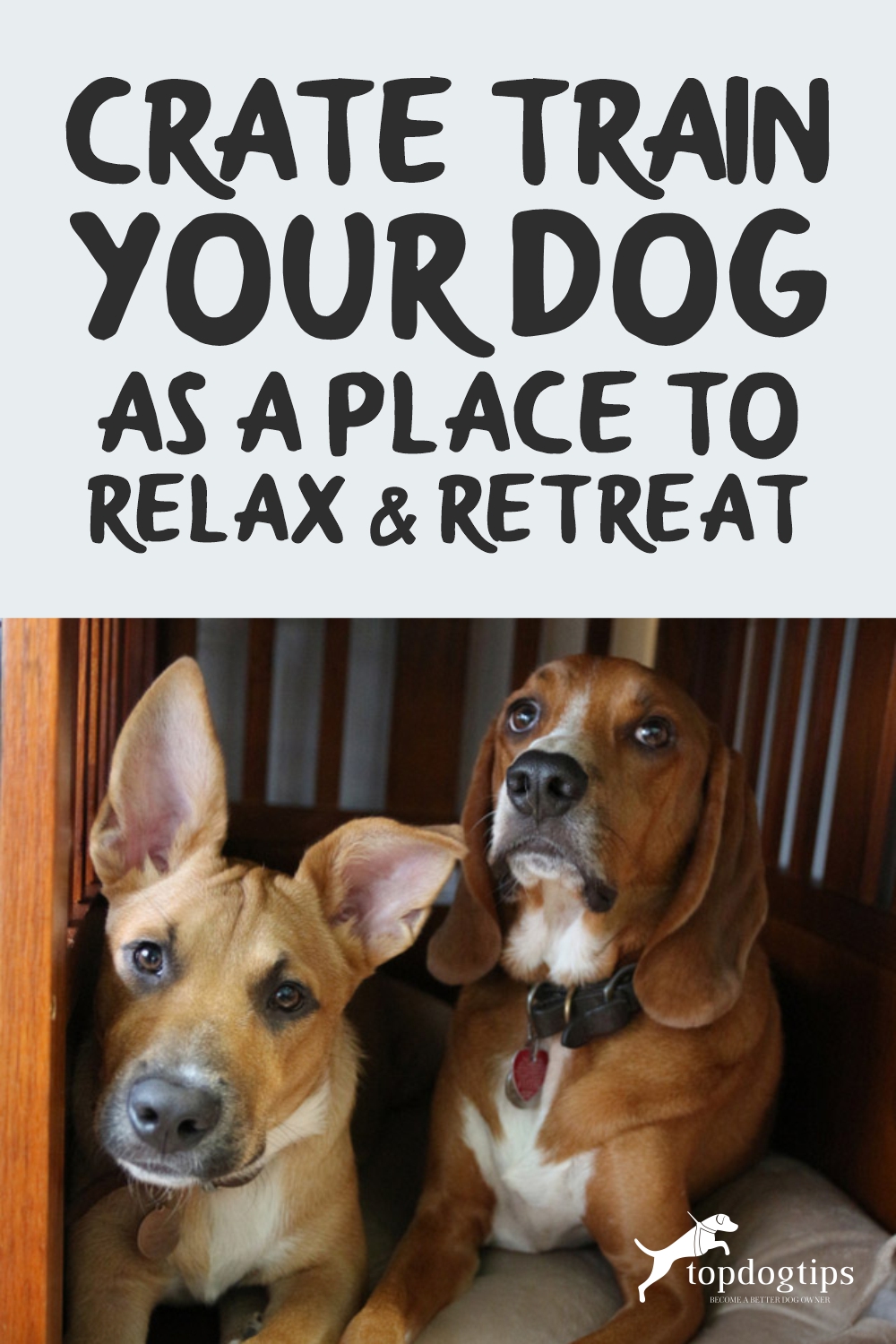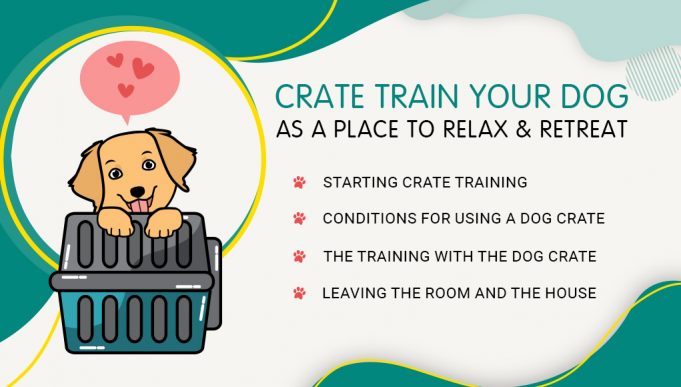For most dogs, a retreat where they can relax and also not be disturbed is very important. A crate or kennel is a good option if you want to create a place of relaxation for your dog. There are dogs that follow their owners at every step when they move around the apartment. Such dogs are permanently attentive and have little time to rest. It is important to establish a resting place, when you crate train your dog you to teach them to have a safe place to relax and retreat. It is often underestimated how much sleep dogs need and that some dogs must first learn to “switch off”.
A kennel or dog crate can also be used in multi-dog households or when integrating a new dog into the family, so the dogs do not yet know each other well and may initially need a little more distance and rest.
STARTING CRATE TRAINING
To crate train your dog may seem like a daunting task, but these three simple steps can help you make the crate the place in the house your dog will prefer.
In the apartment, a dog crate is best placed so that it is not directly in the passage area, but it should also not be completely isolated. Ideally, the dog should be able to participate in the day's events from his box. In the car, a dog crate can have a calming effect on the dog if it has already been linked to relaxation and through the privacy screen that minimizes environmental stimuli.
When setting it up, care should be taken to adhere to the particular floor preference. For many dogs, this means placing blankets or pillows in the crate, as they prefer soft surfaces. However, there are also dogs that like to rest on hard surfaces and avoid soft pads, in such a case you have to take into account the preferences of the particular dog. Especially in the warm summer months, a crate should combine different floor textures in the form of lying zones: warm and soft, cool and hard. This serves to allow the dog to regulate its body temperature independently.
If you do not have much space to store a dog crate, you can resort to various models of foldable dog crates. However, I would not use this type of dog crates for transportation in the car, as they are not very stable. However, they are great for setting up in the home, for the workplace or as a place to relax on vacation. Meanwhile, there is a wide range of dog crates and kennels that can help you crate train your dog.
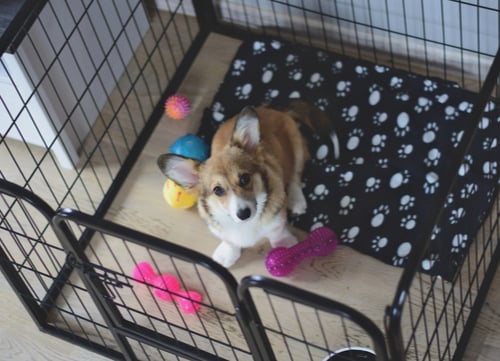
CONDITIONS FOR USING A DOG CRATE
There are a few things you should think about when using a dog crate.
- A dog crate must be considered a safe place for your dog to rest. If your dog is alone in the crate, it is a sign that he wants his rest. Children and other people must then accept this at that moment and really leave him alone.
- Never use a crate as a punishment!
- Be sure to take enough time to get your dog used to the crate so that he also understands the purpose of this place for which it is intended: peace and security.
- A dog crate can help get your pup housebroken.
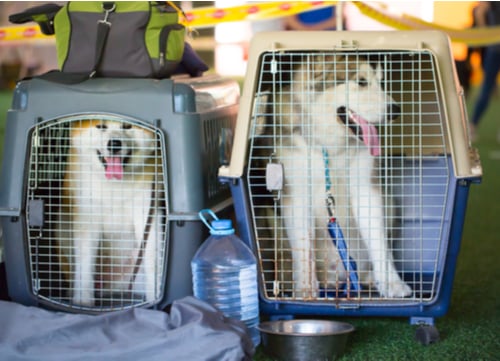
THE RIGHT CRATE SIZE
When you crate train your dog, always use the crate size that is appropriate for your puppy's breed. Keep in mind that your puppy will still need to be able to lie, stand and turn around in the dog crate when he is fully grown. Don't buy a crate that offers too much space. Especially for large breed puppies, the dog crate is often way too big to begin with. There are different types of boxes that you can use for this purpose. Discover our range of dog crates here.
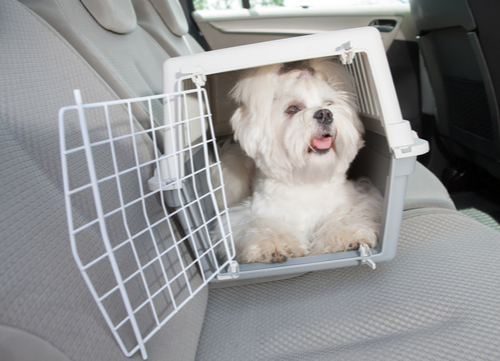
DOWNSIZE DOG CRATE
To avoid having to constantly buy a new crate as your puppy grows, you can reduce the space in the dog crate so that your puppy can still lie comfortably in it. You can do this, for example, by dividing the crate into two parts with an additional (wooden) wall or by placing a crate of the appropriate size inside the crate, where you take out one side towards the door of the crate. Be sure to reduce the size of the crate with something that your puppy can't climb up on.
Otherwise, there is a risk that he will hang on the wall or fall down. Only then, if the dog crate is small enough, use it to prevent your puppy from using it as a toilet as well. In this case, when you crate train your dog, it can be used for housebreaking as well. This is because dogs, by nature, do not want to do their business in their sleeping place. If the room is too big, you will not achieve this goal.
However, this also means that you need to watch your puppy's signals very closely and get him out of the crate when he indicates that he needs to. If you do not do this, your dog will learn that he is allowed to do his business on his bed. For this reason, it may be necessary to move the dog crate to the bedroom or hallway in the evening and at night.
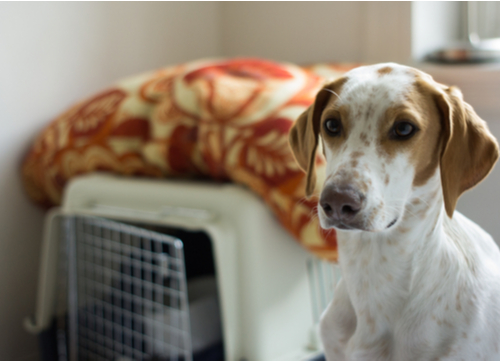
THE RIGHT LOCATION FOR THE DOG CRATE
When choosing the location for the dog crate, it is very important to find a suitable place. Place the box in a quiet place in the living room, from where the puppy can overlook the entire room. Unsuitable locations are in front of the TV or on frequented walkways in the room. You should also avoid a place by the heater or a window because of drafts and temperature fluctuations.
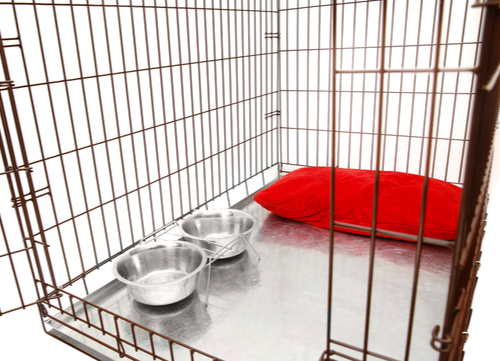
THE FIRST IMPRESSION OF THE CRATE
Before you introduce your dog to the box, you should line it with a particularly soft and comfortable dog cushion. For this purpose, you can choose, for example, the dog pillow from Beeztees or Lief! In any case, it is important that the puppy can not slip. Let your puppy get to know the crate by regularly placing a fine treat in the crate.
You can also put your puppy in it as soon as he gets tired and makes an effort to go to sleep. When you crate train your dog, the first contact with the dog crate must always be positive! If something to eat is not interesting enough to lure your puppy into the crate voluntarily, you can also put his favorite dog toy inside. At this stage, the door must always remain open. If necessary, temporarily fix the door so it doesn't accidentally slam shut when your puppy is in the crate. And: Never force your puppy to go into the crate!
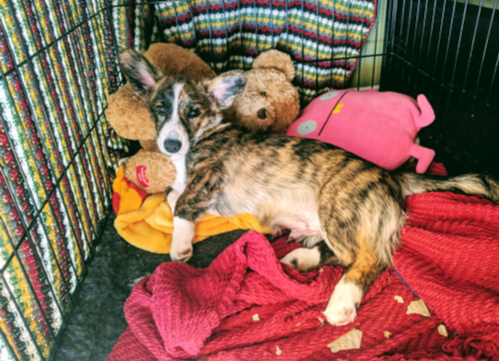
THE TRAINING WITH THE DOG CRATE
When your puppy easily goes into the crate by itself, the actual training with the dog crate can begin. From now on, give your puppy his food in the crate. To do this, place his dog bowl as far back in the crate as possible so that he has to go all the way through the crate to get to his food. If this doesn't work from the start and your young dog doesn't dare go that far in yet, place the dog bowl at the entrance. Each time you feed your puppy, the bowl will then move a little further into the crate.
Once feeding in the crate is going smoothly, you can occasionally close the door while feeding. However, open the door again immediately after your puppy is finished eating. As you go along, try to keep the door closed a little longer at a time, in about five minutes after the feeding is finished. Avoid your puppy whining before you open the door. In this case, your puppy isn't ready yet and you've gone a little too fast.
TEACH COMMAND AND REWARD
If the training with the food bowl is relaxed and you can easily close the door for up to five minutes, go one step further and try to teach your puppy a command to send him to the dog crate. For example, this can be the command “box” or “crate”. Never use this command to punish your puppy. The crate must always remain a pleasant place for your dog. Reward your puppy when he goes quietly into the crate and you close the door for a moment. After a few moments, open the door again and reward your puppy when he stays relaxed. For example, use one of our tasty dog treats for this purpose. Practice patiently until your puppy understands the command. As time goes on, keep the door closed a little longer and longer. Be sure to stay in the same room while doing this, though.
LEAVING THE ROOM AND THE HOUSE
If your puppy remains calm when he is in the dog crate and you close the door for an extended period of time, then start leaving the room for short periods of time. Keep extending this time period a little further and further as well. When you can leave your puppy alone for around 30 minutes, then take it a step further again and leave the house for a moment. Also practice leaving the house by stretching out the time outside more and more.
Don't say goodbye for an unnecessarily long or emotional time. Reward your puppy when he goes quietly into the crate, then walk away. Likewise, reward him if he stays quiet when you come back and open the crate. If this all works smoothly, you will have a dog that has a positive relationship with his crate. In this way, the crate can help teach your dog to stay home alone.
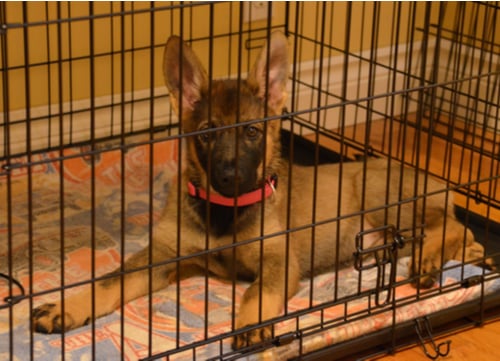
YOUR PUPPY IS STILL WHINING IN THE CRATE, NOW WHAT?
Your puppy may continue to whine when he is in the crate. This may be because he feels another need at that moment, such as being hungry or needing to go to the bathroom. On the other hand, of course, it is also possible that you went too fast during the training with the dog crate. In this case, you should take a few steps back in the training.
NEVER KNOCK ON THE CRATE!
Please do not hit or knock on the dog crate to get your puppy quiet! In the worst case, your young dog will be frightened and will associate the crate with a feeling of fear. He may even develop a fear of you, the owner, because you are the one who banged on the crate. When your puppy whines in the crate, he often does it for a reason: for example, he needs to get out to do his business, he's hungry, he feels lonely, or he's bored. So try to find out why your puppy is whining and act accordingly.
FREQUENTLY ASKED QUESTIONS (FAQS)
How long does it take for a dog to get used to sleeping in a crate?
Once your dog will stay quietly in the crate for about 30 minutes with you mostly out of sight, you can begin leaving them crated when you're gone for short time periods and/or letting them sleep there at night. This may take several days or weeks.
At what age should you stop crating a dog?
The average age for most dogs is from 18 to 24 months, although it may take some active or chewing dogs longer. It really doesn't matter, at this moment, most dogs look at their cupboard and don't have a problem chewing happily or on a nice cupboard toy while away.
How long should a dog be in a crate each day?
It's perfect for most adult dogs to spend the day (with a walk in the center) in a crate “nine hours maximum” and only eight hours at night, unless they're older or big dogs who have to stretch joints. I'm working at home, so during the day I follow the actions of my dogs.
Is crate training bad for your dog?
Crate education is a vital part of bringing your dog and home at any age. The benefits of being properly trained cabinet are puppies, adult dogs and seniors in one way or another. Crate training offers a feeling of protection and security for dogs and provides more peace of mind to owners.
Final Thoughts
Before you put your puppy in the dog crate or send him inside, you should take off his collar. This is because a clumsy movement could cause him to get caught somewhere with the collar and have a traumatic experience or even suffocate.
For a successful crate training, it is therefore important to consider;
- Choosing the right size and location for the crate
- Letting your puppy get used to the dog crate slowly and gradually
- Slowly extend the time spent in the crate.
- You can also use the crate for your puppy's cleanliness training
- Never use the dog crate as a punishment!
READ NEXT: The 10 Best Dog Crates for Training and Other Tasks
